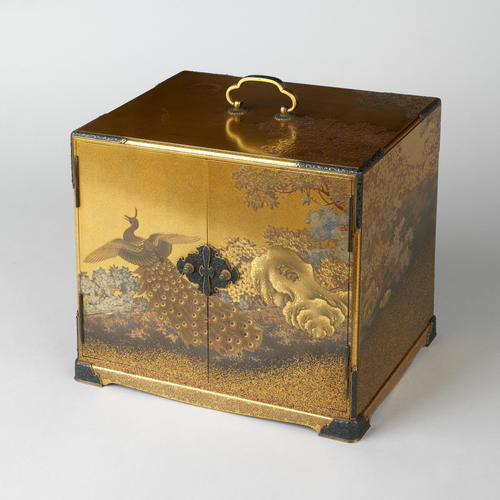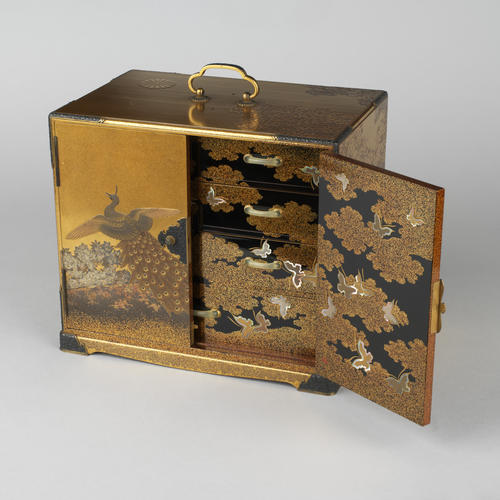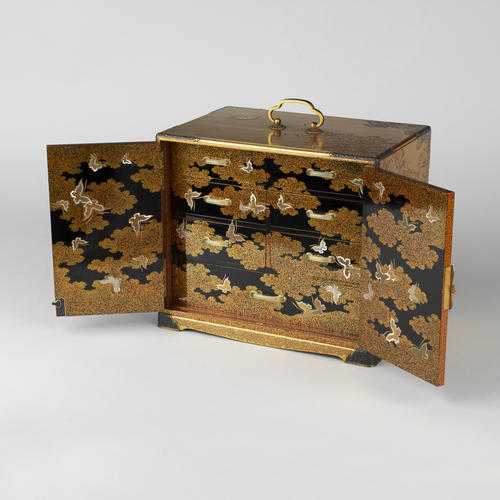-
1 of 253523 objects
Miniature cabinet of drawers c.1907
Black, gold and silver lacquer, with inlays of mother-of-pearl, horn and shell, on wood | 21.3 x 24.9 x 16.6 cm (whole object) | RCIN 33967

Akatsuka Jitoku (1871-1936)
Miniature cabinet of drawers c.1907

Akatsuka Jitoku (1871-1936)
Miniature cabinet of drawers c.1907

Akatsuka Jitoku (1871-1936)
Miniature cabinet of drawers c.1907



-
This piece is the work of Akatsuka Jitoku, who has signed his name in gold and red lacquer inside the right-hand door. One of the most accomplished lacquerers of his generation, Jitoku was director of the Japan Artistic Craft Association (Nihon kōgei bijutsu kyōkai) and did much to promote the recognition of lacquer arts by the Imperial Art Academy, to which he was elected a member in 1930. His work was in high demand for imperial presentation pieces; and the dozen or so works by him known in collections outside Japan today were almost all official gifts. This portable cabinet was selected as a Coronation present for Queen Mary by the Emperor Meiji and Empress Shōken in 1911. The imperial chrysanthemum crest (kikumon) appears on the top near the carrying handle, and the lock-plates of shakudō also have chrysanthemum bud knobs.
The decoration represents Jitoku’s ‘sunlight style’, which characterised his artistic output in the years 1905–20. This period was distinguished by the lavish use of gold ground to evoke the impression of warm sunlight, in contrast to Jitoku’s colder and sparser nocturnal designs of the preceding years. Here, a resplendent fundame ground is embellished with a peacock taking flight over blooming azaleas. The peacock’s feathers are studded with aogai (inlaid pieces of shell on lacquer) to form the green eyes. On the reverse is a peahen, and inside are seven drawers. In 1907, Jitoku won a gold medal at the Tokyo Exhibition for a casket similarly decorated with peacocks and azaleas, and it is possible it was this example. The cabinet may have been purchased later by the Imperial Household Agency and the chrysanthemum mon added before presentation, which might explain its unusual location on the upper surface.
Text adapted from Chinese and Japanese Works of Art in the Collection of Her Majesty The Queen: Volume III and Japan: Courts and Culture (2020)
Provenance
Presented to Queen Mary by the Meiji emperor and Empress Sho-ken (1849–1914) of Japan as a coronation gift, June 1911. Recorded in Queen Mary's Bibelots Vol. I, no. 524. Displayed in the Chinese Chippendale Room at Buckingham Palace in 1912.
Lent by Queen Mary to the 1915 Loan Exhibition of Japanese Works of Arts and Handicraft from English Collections, 14 October-13 November, which was held in aid of the British Red Cross Society and the Order of the Hospital of St John of Jerusalem in England. -
Creator(s)
(nationality)Acquirer(s)
-
Medium and techniques
Black, gold and silver lacquer, with inlays of mother-of-pearl, horn and shell, on wood
Measurements
21.3 x 24.9 x 16.6 cm (whole object)
Category
Object type(s)
Place of Production
Japan